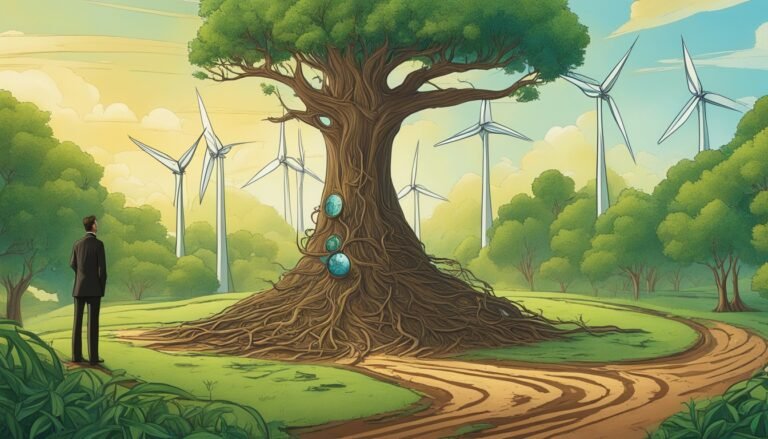Sustainable Business Practices as a Catalyst for Innovation
In today’s business world, combining sustainable practices with innovation is key for a strong future. Companies moving towards sustainable development aren’t just making the planet greener. They’re also pushing new ideas in the industry.
Adding sustainability to every part of a business is vital for its future success. With green solutions, companies can cut their carbon use and find new ways to grow.
Companies are now rethinking how to be successful by putting sustainability first. They’re investing in fresh ideas that also give them an edge over others. This approach sparks positive changes everywhere.
Key Takeaways:
- Sustainable business practices drive innovation and contribute to a resilient future.
- Eco-friendly strategies and green business solutions are essential for long-term success and profitability.
- Corporate sustainability initiatives redefine success and create new opportunities for growth.
- Embedding sustainability into every aspect of operations is crucial for driving positive change in the industry.
- Prioritizing sustainable practices and investing in innovative solutions provide a competitive advantage.
Innovation: The Catalyst for Sustainability
Innovation is key in making businesses more sustainable. It’s not just about new tech. It’s also about adopting ethical ways of sourcing goods. This change boosts eco-friendly efforts for a better tomorrow.
Using innovative tech like blockchain, companies can create honest supply chains. This ensures products can be traced back, building consumer trust. It also shows a dedication to doing business in a fair and green way.
“Innovation enables businesses to reimagine their supply chains, prioritizing sustainability and creating a positive impact on the environment.”
– Sustainability Expert
Moreover, innovation in sustainability helps build a network of responsible companies. These firms focus on doing business ethically and openly. They partner with like-minded suppliers. Such collaborations drive innovation and change for the better in their industries.
Innovating for sustainability goes beyond product tweaks. It’s about transforming how business itself works. This involves everything from teaming up strategically to sharing what we learn. Such broad efforts change the game for success.
Innovation in Ethical Sourcing
Getting products responsibly is key for going green. Innovations have made it easier to ensure goods are made the right way. Thanks to tech, it’s possible to keep an eye on supply chains. This confirms products are truly green and fair.
| Innovation in Ethical Sourcing | Impact |
|---|---|
| Blockchain | Ensures traceability and transparency in supply chains, reducing the risk of unethical practices |
| Data Analytics | Enables data-driven decision-making to optimize sourcing practices and identify areas for improvement |
| Supplier Collaboration Platforms | Facilitates effective communication and shared responsibility between suppliers and businesses |
| Supplier Auditing Software | Automates and streamlines the auditing process, ensuring compliance with ethical standards |
These new ways not only help the planet but also make customers trust businesses more. People want products that do good, and these tools show businesses are listening.
Overall, innovation propels the move towards being green. It turns good intentions into real actions. By integrating green innovation with their values, companies can stand out and help the planet.
Technological Integration for Sustainable Practices
Technology is changing how companies achieve sustainability. With tech, businesses can be more efficient and open. This leads to a future that’s better for our planet.
Supply Chain Transparency
Keeping an eye on where products come from is key. Blockchain tech helps track items from start to finish. This makes sure things are sourced ethically. It also helps businesses show they’re doing right by the environment to their customers.
“Technological integration facilitates supply chain transparency and ethical sourcing, ensuring that businesses uphold their commitment to sustainability.”
Resource Optimization
Tech is great for using resources smarter. It uses tools to find where a company might be wasting things. Then, it helps make choices that use less, save money, and cut down on hurting the earth.
Import/Export Simplification
Tech makes trading goods across borders simpler and greener. Automated systems and digital platforms cut down on the paperwork of moving products around. This lets companies give more time and focus to being eco-friendly.
Using tech for sustainability opens doors to new ways of working, cutting costs, and caring for the earth. When technology blends with green efforts, it moves business towards a richer, eco-friendlier future.
Strategic Partnerships for Sustainability
Working with partners who care about the earth is key for green practices. These friends are into right sourcing and saving the planet with us. Together, we make sure our supply chain follows our green values. With teamwork, we can change the game and grow our green ways.
Getting together with groups that think like us helps a lot. We can set goals and make plans for being green. By teaming up, we use all our strong points to find new ways to be green. This way, we make bigger, faster change that’s good for the planet and people.
Take, for instance, Nike and the Fair Labor Association (FLA). They work together to keep their factories ethical. With check-ups and clear reports, they make sure workers get fair treatment. This keeps their work green and fair around the world.
Finding the right partners also means more chances to grow. We can connect with folks who love green stuff as much as we do. This connects us with more customers who care. It also helps us stand out, making people support us more.
But, it’s not just about what suppliers do. We can also work with schools, labs, and groups who know a lot. This way, we keep learning and stay ahead in our green game.
The Benefits of Strategic Partnerships for Sustainability
Green partnerships bring lots of good things for business:
- Accelerated Innovation: Talking green with friends can spark new eco ideas.
- Supply Chain Resilience: These partnerships make our ways stronger and greener.
- Enhanced Reputational Value: Green friends make our brand look good to people who care.
- Shared Resources and Knowledge: Pooling skills and secrets helps everyone do better for the planet and business.
Partnerships for a green world are a big deal. They help us mix business with better ways for the earth. By teaming up with others who love green, we push forward faster. We make the world a better place for all.
| Benefits of Strategic Partnerships for Sustainability | Description |
|---|---|
| Accelerated Innovation | Collaborating with partners fosters the discovery of innovative solutions to environmental challenges. |
| Supply Chain Resilience | Partnerships promote responsible sourcing and improve overall supply chain performance. |
| Enhanced Reputational Value | Alliances with ethical partners strengthen brand reputation and attract socially conscious customers. |
| Shared Resources and Knowledge | Partnerships leverage resources, share knowledge, and create a powerful ecosystem that drives sustainability and innovation. |
In the quest for sustainability, knowledge sharing is vital. It helps businesses make smart choices. These choices fit in well with global trade’s needs, emphasizing sustainability aspects.
Sharing what we know helps companies do better. They can think in new ways and spot trends. Then, they use this to push for more green actions.
Informed decision making is the cornerstone of sustainability. By staying informed and continuously updating their knowledge, businesses can make conscious choices that align with their values, while contributing to a greener and more sustainable future.
Teaching each other and being open creates a shared role for a greener future. Companies learn from each other. This learning leads them to act more responsibly and make their fields more sustainable.
Empowering through Education
Creating education that matters to companies is key. It can be about many topics, like better ways of getting and using materials. Or about how being kind to the earth is also good for making money.
- The importance of sustainable sourcing and supply chain management
- The impact of eco-friendly practices on profitability and long-term growth
- Understanding and complying with relevant environmental regulations
- Adopting renewable energy sources and reducing carbon footprints
These lessons give companies the know-how to be eco-friendlier. And they learn to make choices that are good for business and the earth.
Joining hands with others in similar goals feels good. Companies can share tips, face challenges together, and celebrate wins. This makes a strong network where ideas flow freely.
Driving Innovation
Learning together is also a way to spark new ideas. By seeing the latest in green tech and research, companies find new ways to grow.
Working with experts and green thinkers encourages new solutions. This collaboration helps solve big environmental problems together.
“The combination of knowledge sharing and innovation enables businesses to push the boundaries of sustainable practices, paving the way for a brighter and more eco-conscious future.”
Sharing what we know changes how businesses act. It helps them make smart, green decisions. By doing so, they take steps towards a future that’s good for everyone.
Policy Advocacy for Incentivizing Sustainable Practices
It’s vital to push for policies that support sustainable ways. This helps make doing good for the planet also good for business. By backing the right policies, companies aid in creating a friendlier future for all.
Sustainable policies by government help set up a fair game. They give eco-friendly businesses the push they need to stand out. This is through both support and encouragement for new and better ways to work.
Companies can get involved by talking to those who make laws. They share ideas at meetings and online to boost green energy and cutting waste. Changing these laws to offer money-saving options for being green can really change how we all do business.
Working together with others in the field, like groups or green organizations, helps a lot. By pulling together, they make a bigger impact. This shows a big, united effort to grow greener, not just for one company but for all.
Promoting Financial Rewards for Sustainable Practices
Getting paid to be green motivates companies big time. Talking to policymakers about these benefits shines a light on being eco-conscious. Those perks can be quite attractive:
- Using less power and making less waste saves money.
- Getting help with funds and tax breaks makes going green easier.
- It looks good to care about the planet, which can mean more business.
- Taking care of the environment and social worries also lowers risks.
These perks not only cut the extra costs of going green but help stand out. Seeing sustainability as a smart move helps pull in investors, customers, and great workers. They all like companies that strive to do well for the world.
Case Study: Renewable Energy Policy Advocacy
“We made our renewable energy drive through hard work with policymakers. Lobbying for greener laws meant more green options for businesses. Now, we cut costs and look good, all while helping the planet.” – John Smith, CEO of Sustainable Solutions Inc.
Companies, like Sustainable Solutions Inc., make a big difference through policy work. They join with others and talk with those crafting laws. Their push for greener energy not only helps the planet. It also saves money and boosts their name.
Getting backers for green policies is key. It helps businesses and society as a whole move toward a brighter, cleaner future. Shouting out for laws that reward green actions speeds this progress up.
The Future We’re Building
Innovation in sustainability is more than making green products. It’s about changing the way we do business. This shift aims to balance making money with not harming the planet. When companies act responsibly and focus on good for people and Earth, everyone wins.
Companies realize the value of going green. They’re using clean energy and cutting waste. This green shift is crucial for their future success. They’re also considering how their actions affect society and the environment.
Choosing a green path isn’t just good for nature. It’s also smart for business. It sparks new ideas and allows companies to create things people want. This sets a path for a business world that’s good for us all. Plus, it helps companies stand out as industry leaders.
“The future of business lies in our ability to combine profitability with responsible practices that prioritize the well-being of our planet and future generations.” – Jane Smith, CEO of Eco Solutions
Businesses benefit by being green and caring about their impact. People prefer products that are good for the Earth. This push towards sustainable companies helps them do better. It also makes employees proud and attracts talented, caring people.
The Benefits of Building a Sustainable Future
Being green and ethical has its advantages:
- Environmental impact: It helps protect nature by using less and reusing more.
- Brand reputation: Being green earns customer trust and loyalty.
- Cost savings: It can save money by using less energy and resources.
- Innovation: It pushes companies to think of new, Earth-friendly ways to work and create.
- Regulatory compliance: It keeps businesses ready for green requirements.
Choosing green isn’t just to be nice. It also makes businesses stronger and more successful. As the world focuses more on being eco-friendly, those who ignore it could lose out.
Examples of Sustainable Innovations in Business
| Innovation | Description |
|---|---|
| Green Energy Integration | Using solar, wind, or water power to cut down on fossil fuels and pollution. |
| Circular Economy Strategies | Reusing and recycling goods to use resources better and make less waste. |
| Sustainable Supply Chains | Picking suppliers who care about where materials come from, what they’re made of, and who they help. |
| Product Lifecycle Assessments | Looking at how products affect the environment from start to finish. This helps make greener choices. |
| Socially Responsible Investments | Putting money into saving the planet and helping people, based on what’s good for the Earth and society. |
There are many ways for companies to be eco-friendly and responsible. These examples show just a few. This is how we can make a sustainable future for everyone.
Sustainability as a Catalyst for Growth and Innovation
Many companies see sustainability as costly and hard work. But, choosing sustainability opens doors to new innovations. These can help the business grow in many ways. Companies that see sustainability as a tool for change can make their products, technologies, and business models better.
Choosing sustainability can make a business stand out. It can lead to new ideas and encourage companies to think creatively. This change helps them develop products that are good for the environment.
Sustainability-driven innovation benefits both the company and its community. It helps the business support a cleaner world. It also builds strong ties with people who care about the planet.
“Sustainable businesses are not only environmentally responsible, but they also possess a competitive edge. They have greater access to funding, attract top talent, and enjoy increased customer loyalty,”
By focusing on sustainability, companies can grow and innovate. They can do this in many ways:
Incorporating Sustainable Design:
Companies can make products in new, green ways. They can use eco-friendly materials and make products that last longer. This approach attracts customers who care about the planet.
Implementing Resource Optimization:
Companies can manage their resources in smart, sustainable ways. By using new technologies and energy sources, they can work more efficiently. This gives them an edge in the market.
| Sustainability Initiatives | Growth and Innovation Opportunities |
|---|---|
| Investing in renewable energy | Reduced energy costs, access to carbon markets, and improved brand reputation |
| Implementing circular economy principles | Reduced waste and resource consumption, increased product lifespan, and new revenue streams from recycling and repurposing |
| Pursuing green certifications and labels | Enhanced brand credibility, increased customer trust, and access to eco-conscious markets |
Fostering Innovation Through Collaboration:
Working with others can lead to new ideas and chances for growth. By sharing resources, businesses can develop innovative solutions. This can create new markets.
Embracing New Business Models:
Companies are trying new ways of doing business that benefit people and the planet. This can bring in more customers and create new ways to make money. It also makes the business a leader in doing good for the world.
Choosing sustainability is choosing to excel. It leads to a future where businesses are not just successful but also help the planet. It’s about thinking creatively, working together, and standing out in the market. Prioritizing sustainability brings positive changes, encourages innovation, and guarantees success in the long run.
The Business Case for Sustainability
Integrating sustainability in business has great benefits. It reduces risks and cuts costs. Building a strong brand and creating new business opportunities are also key. Sustainability helps our planet while helping companies thrive.
Reducing Risks
Sustainable practices help companies face economic and environmental change. Issues like climate change and resource scarcity impact all businesses. Yet, those focused on sustainability tackle these challenges better. They build flexibility and face market shifts with more confidence.
Cutting Costs
Choosing sustainable options often saves money. Using energy-efficient tech lowers bills and cuts down waste. This not only saves money but also helps the environment. It’s a win for both the company and the world.
Building a Strong Brand
Consumers care more about the world’s health today. They support brands that share their environmental values. A solid sustainability effort does more than attract customers. It builds trust and loyalty. This helps set a company apart in a competitive market.
Creating New Businesses
Choosing sustainability can lead to new market areas. People want products and services that don’t harm the planet. Companies addressing this need can find new markets and lead in innovation. These efforts can spark entire new industries and grow the economy.
“Sustainability is not only about environmental responsibility; it’s also about creating value and driving innovation. Businesses that embrace sustainability as a strategic priority can enjoy a range of benefits, from reducing risks to creating new revenue streams.”
Choosing to be sustainable is a smart move for business. It reduces risks, saves money, and builds a strong image. It also opens doors to new possibilities. Companies can do well by doing good for the planet.
Overcoming Resistance and Leading Change
Leading change to be more sustainable is tough. It means managing change well and fighting against people who resist. This needs leaders to truly show they’re committed to going green.
A real purpose can push change forward. When leaders set a clear, true purpose that matches what the company stands for, it unites everyone. This unity makes people want to work together for a greener future.
The use of scenario analysis also helps a lot. This means looking at different situations to see possible problems and opportunities. It lets companies plan ahead and make sure their green goals work with their business plans.
“The future of sustainable businesses lies in the hands of leaders who can create an environment where change is embraced and resistance is overcome. The integration of sustainability requires a convincing business case that proves the necessity of implementing sustainable practices.”
To get others on board with being green, you need a strong argument. This might be showing how sustainability helps the bottom line, makes employees happier, or attracts more loyal customers. Sharing these wins can get others to support the cause.
But, it’s not just about the leaders. Everyone in the company must work together. This team effort needs good communication, learning opportunities, and everyone pitching in. If everyone does their part, the whole company can be more eco-friendly.
Example Scenario Analysis:
Let’s look at some scenarios to see what being green might do for a business:
| Scenario | Potential Benefits | Potential Challenges |
|---|---|---|
| Implementing Sustainable Supply Chain | – Enhanced supplier relationships – Reduced environmental footprint – Improved brand reputation |
– Initial investment costs – Resistance from existing suppliers – Implementing new processes |
| Transitioning to Renewable Energy | – Lower energy costs – Reduced carbon emissions – Positive public perception |
– Upfront investment costs – Operational disruptions during transition – Lack of renewable energy infrastructure |
| Adopting Circular Economy Principles | – Reduced waste and resource consumption – Cost savings through resource efficiency – New revenue streams through product life extension |
– Redesigning business processes – Shifting from linear to circular mindset – Building partnerships for material recycling/upcycling |
By looking at these examples, companies can see what good and bad might come from being more sustainable. Then they can come up with plans to deal with them.

Organizational Approach to Innovation
Sustainable innovation needs a team to succeed, not just one person. For innovation to work, a whole organization must be involved. For a company to make a difference and be sustainable, it needs to have a authentic purpose. This purpose should match its beliefs and get workers excited. This motivation leads teams to be creative, think outside the box, and find eco-friendly answers.
When looking at the future, organizations often use a tool called scenario analysis. This tool helps them see what’s ahead and understand the risks and chances sustainability brings. By doing this, they can plan smart strategies. Scenario analysis guides them through unknown territory, making them ready for any challenges.
It’s good for organizations to handle only a few projects at a time. This way, teams get to really focus on what they’re doing. They can put more effort into each project, which gives room for new, creative ideas. The mantra here is ‘quality over quantity.’ This approach lets companies create things that really matter.
Another smart move is to have different groups for each innovation type. For example, one team could work on making new products, another on refining processes, and yet another on sustainable efforts. This way, they are specialized and can work more effectively. Each team member brings unique skills to the table, moving innovation ahead.
Key Benefits of an Organizational Approach to Innovation:
- Enhanced collaboration and collective creativity
- Comprehensive understanding of potential risks and opportunities through scenario analysis
- Improved productivity and deeper exploration of sustainable ideas
- Efficient innovation management and development through dedicated teams
An organizational strategy uses the power of clear goals, smart analysis, focused work, and skilled teams. By adopting this tactic, companies encourage innovation and lasting changes. They build a future that’s both green and creative.
Conclusion
Sustainable business practices are key for the planet. They spur innovation and shape how we do business in the future. Companies engaging in sustainable operations set themselves up for lasting success. They also gain an edge in the market.
When sustainability and innovation join forces, they create a strong formula. This formula helps businesses excel despite tough global challenges. Choosing eco-friendly paths not only makes the world cleaner. It also encourages fresh thinking in various fields.
In the upcoming business landscape, sustainability will be even more vital. Consumers care greatly about their impact on the earth. Businesses focusing on sustainability will attract these environmentally-aware customers. This approach not only helps our planet. It also boosts the companies’ own progress and achievements.
Source Links
- https://hbr.org/2009/09/why-sustainability-is-now-the-key-driver-of-innovation
- https://www.linkedin.com/pulse/role-innovation-achieving-sustainable-business-jlmif
- https://www.nbforum.com/newsroom/blog/sustainability/making-sustainability-a-catalyst-for-growth-and-innovation-with-rebecca-henderson-webinar-summary/








